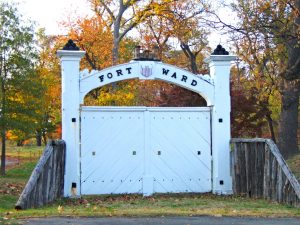 Alexandria, named after John Alexander, an 18th-century Scottish landowner, was founded in 1749 and has a rich and varied history. It was one of the 10 busiest ports in America and an important tobacco trading post.
Alexandria, named after John Alexander, an 18th-century Scottish landowner, was founded in 1749 and has a rich and varied history. It was one of the 10 busiest ports in America and an important tobacco trading post.
While the largest slave-trading company in the country was based here, Alexandria also was home to a large free black community. During the Civil War, the city operated as a supply center for Union troops. Here are four of Alexandria’s historic sites where you can trace the history of the city.
Fort Ward Museum and Historic Site
During the Civil War, a system of forts and batteries were constructed that were known as the Defenses of Washington. Fort Ward, named for the first naval officer of the Union to be killed in the Civil War, is the best-preserved of these fortifications, and some areas have been reconstructed and restored to their original condition.
You can visit the fort and museum, located in a 45-acre park, and learn about Alexandria as an occupied city, and its later importance for the rights of African-Americans. There are living history programs where you get the chance to meet and talk to re-enactors portraying Civil War soldiers and civilians.
Freedom House Museum
Franklin and Armfield was once the largest slave-trading company in America, and the Freedom House Museum is housed in what was once part of the company’s headquarters. The building was used as a pen for enslaved individuals being shipped to the cotton and sugar plantations of the Deep South.
Exhibits will enable you to understand the harsh reality of Alexandria’s role in the domestic slave trade through first-person accounts and details of the company’s operations.
Alexandria History Museum at The Lyceum
The Lyceum was constructed in 1839 to promote educational and cultural opportunities for the public. Among other uses, the building also served as a hospital for Civil War casualties. Now, the Alexandria History Museum houses exhibitions telling the story of Alexandria through archaeological artifacts, historic finds, maps, photographs, and original artwork. Changing exhibitions feature at the museum throughout the year.
Torpedo Factory Art Center
On the day World War I ended, work began on the construction of a U.S. naval torpedo station in Alexandria. During World War II, there was intense production of submarine and aircraft torpedoes. With this growth in production, 10 more buildings were added to the complex. After the war, the buildings were used as a storage facility until 1969 when a proposal to turn the buildings into working studio spaces for artists was accepted.
In 1974, the Torpedo Factory Art Center opened to the public. More than 165 professional artists work, exhibit and sell their art here. The many galleries feature guest exhibitions and events throughout the year, and the center attracts more than half a million visitors a year.
These sites and others provide an insight into a city that played an important role, not only in the history of Northern Virginia but also that of the United States.
Image via Flickr by sabreguy29/Under use by CC BY 2.0







